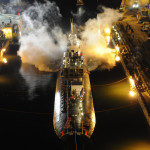

A fire raged through the nuclear-powered Los Angeles-class fast attack submarine USS Miami on Wednesday 23 May while sitting in a dry dock at the Portsmouth Naval Shipyard in Kittery, Maine. The fire is reported to have started during the evening hours and was extinguished through the heroic efforts of shipyard firefighters, Miami crewmembers, and firefighters from more than a dozen fire departments from Maine and New Hampshire.
The USS Miami (SSN-755) was built by the Electric Boat division of General Dynamics in Groton, Connecticut and was commissioned on 30 June 1990 at a cost of approximately $900 million. The boat is permanently assigned to Submarine Group Two in Groton, Connecticut. The Miami was laid up in a Portsmouth dry dock on 1 March 2012 to undergo a 20-month overhaul and system’s upgrade.
According to US Navy sources, the submarine’s nuclear reactor was not in operation at the time of the fire and no weapons were aboard. The Navy also indicated that some internal equipment had been removed to facilitate the overhaul and some compartments had been gutted in preparation for necessary upgrades.
Rear Admiral Richard Breckenridge, commander of Submarine Group Two, speaking for the US Navy said that the fire raced through confined internal spaces of the boat that are very difficult to access creating “a challenging situation for initial responders.” The Admiral went on to praise the heroic efforts of the firefighters responding to the emergency and the crew of the USS Miami in saving the ship.
By all indications, the fire was confined to forward compartments and presented no threat to the ship’s nuclear propulsion system or engineering spaces. Preliminary damage assessments have identified extensive damage to the ship’s living quarters, forward torpedo room, and the command and control spaces. Admiral Breckenridge said that the rear compartments of the ship remain habitable and noted that some crewmembers remained in the rear section throughout the fire.
The Navy has made it quite clear that there is no danger to the ship’s reactor as it has been shut down for over two months. Although it is not known how many crewmembers were aboard the ship at the time of the fire, Navy sources have stated that the engineering compartments and the nuclear-propulsion spaces were fully manned throughout the emergency. Initial reports counted seven persons injured while battling the fire; two crewmembers, two civilian firefighters, and three firefighters with the shipyard’s fire department. All of the injuries are reported to be relatively minor.
The cause of the blaze has not been announced yet and the extent of the damage to the ship will not be known until a thorough investigation is completed. Considering the age of the Miami, salvage and repair of the ship is a question that will take some time to be answered. Admiral Breckenridge stated that no decision on salvage could be addressed until a detailed damage assessment could be completed.
Before workers can begin to introduce fresh air into the internal spaces to vent smoke and dangerous fumes from inside the ship, the damaged compartments have to be cooled sufficiently to avoid the possibility of a backflash. Once this venting operation is completed, damage-control teams will then begin a detailed damage assessment.
Since the Miami is no longer a state-of-the-art ship, some analysts believe that returning her to active service following a fire of this intensity is very unlikely. Should the ship require extensive repairs, the US Navy will have to decide if salvage costs can be justified, given the Miami’s age, in light of ongoing efforts to reduce defense spending. Repairs could prove to be cost prohibitive and the Navy may be forced to scrap the ship.
















